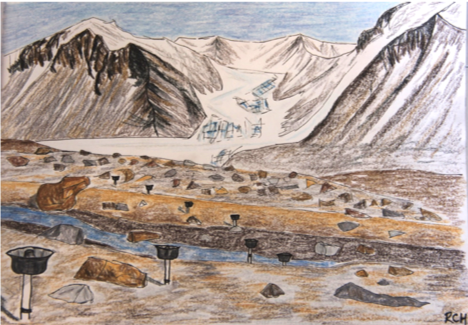
Although it may seem that the streams of the McMurdo Dry Valleys are not well connected to the surrounding dry soils, the aeolian transport of sediment, snow, particulate organic matter, and viable organisms into the stream channels may be an important vector of connectivity between soils and streams. Previous work has focused on the aeolian transport of sediment across valley-wide spatial scales, finding that strong foehn winds are extremely important in transporting sediment and organisms (Nkem et al. 2006, Sabacka et al. 2012, Michaud et al. 2012). Here, we focus on the smaller spatial scale of stream channels, where the incised geomorphology may promote the deposition of snow and particulate matter.
An explicit goal of MCM5 is to document and quantify the spatial and temporal connections between landscape units, and this monitoring activity allows us to characterize the connection between soils and streams, testing H1 and H2.
During the 2018-2019 field season, we installed 6 transects of 8 aeolian collectors across Von Guerard Stream in order to quantify the amount of allochthonous material deposited into stream channels by wind (Fig. 1). Three of the transects extend across deeply incised channels, while three of the transects extend across relatively shallow channels. These collectors will be sampled annually starting during the 2019-2020 season. We predict that the quantity of deposited sediment will be greatest on the up-valley side of deeply incised channels, where the geomorphology captures sediment transported by the strong down-valley foehn winds. In addition to installing the collectors, we sampled nearby sediments for invertebrate counts and soil moisture. Finally, during the 2017-2018 and 2018-2019 seasons, we sampled stream-channel snowbanks and analyzed them for sediment mass and major ions in order to quantify the contribution of snowbanks to streamwater chemistry.
